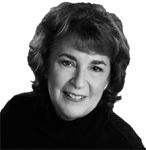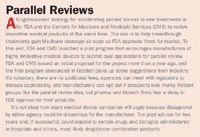FDA Gets a New Look
Pharmaceutical Executive
Agency expansion and globalization promote innovation, collaboration, and organizational changes
The FDA is under pressure to encourage medical product development, monitor an increasingly global supply chain, and accomplish everything with ever-tighter resources. In the last few years, Congress added tobacco oversight to FDA's plate and expanded oversight of food safety. And that's on top of mandates to speed new therapies to market while ensuring they are safe and risk-free.

Jill Wechsler
The added responsibilities come amid criticism on all sides. Pharma companies complain that an overly cautious approach to potential safety issues generates unreasonable requirements that stymie innovation. Patient and disease groups echo these concerns and want revised risk calculations that incorporate views of the critically ill. Yet, consumer representatives and some members of Congress continue to highlight drug safety problems and demand more extensive testing of new drugs both prior to approval and after coming to market.
Commissioner Margaret Hamburg's response is to promote new approaches to drug development, including streamlined clinical research methods and development of biomarkers and other new tools for product evaluation. Hamburg outlined these strategies in an October 2010 white paper on FDA's Regulatory Science Initiative, followed by a "Strategic Plan for Regulatory Science" in August. A "blueprint" on "Driving Biomedical Innovation" issued this October outlines how FDA will revise burdensome and obsolete regulations, provide more help to small biomedical companies, and create a "rapid drug development pathway" for critical therapies. Hamburg also is collaborating more with other federal agencies on research, enforcement, and product evaluation initiatives (see sidebar).

Parallel Reviews
New Structure
To better handle new scientific approaches and today's global regulatory environment, Hamburg has spent the past year orchestrating a top-level reorganization of FDA. The most visible change is the appointment of a cadre of deputy commissioners to coordinate agency operations, which involve some 12,000 employees and more than 20 percent of US consumer products.
A new deputy commissioner for global regulatory operations and policy, Deborah Autor, is in charge of FDA's Office of International Programs and Office of Regulatory Affairs, which operates the agency's far-flung field force. This includes a growing number of foreign offices, established to monitor a surging volume of food and medical products imported into the US. Autor is quite familiar with supply chain vulnerabilities and import issues, as she previously headed the Office of Compliance (OC) in the Center for Drug Evaluation and Research (CDER), which also has undergone a major facelift.
Michael Taylor remains the head of FDA's Office of Foods, overseeing the Center for Food Safety and Applied Nutrition (CFSAN) and the Center for Veterinary Medicine (CVM). An FDA veteran, Taylor has the daunting task of implementing food safety legislation without the resources to inspect more facilities and to expand oversight as required by Congress.
Chief Scientist Jesse Goodman is point man on regulatory science. He also oversees the National Center for Toxicological Research, counter-terrorism, and agency integrity and professional staff development, along with special offices for women's health and for minority health.
Counselor to the commissioner, John Taylor, who served as Hamburg's temporary deputy commissioner for much of this past year, returns to his advisory role, but with added staff responsibilities. He monitors policy and planning functions, legislative relations, and external affairs.
Spielberg Up Front
Particularly important to pharma, a new deputy commissioner for medical products and tobacco, Stephen Spielberg, was brought in to coordinate the activities of FDA centers for drugs, biologics, medical devices, and tobacco products. Spielberg also oversees a cluster of programs that affect multiple products, including orphan drugs, pediatric therapeutics, combination products, and clinical research practices.
Spielberg comes to FDA with 30 years experience in academia and industry. He has served on FDA advisory committees and got to know Hamburg as a member of FDA's Science Board. Most recently, he headed up a new Center for Personalized Medicine and Therapeutic Innovation at Children's Mercy Hospital in Kansas City, Mo. While in industry, he chaired a Pharmaceutical Research and Manufacturers of America (PhRMA) pediatric task force and was instrumental in promoting the Best Pharmaceuticals for Children Act, enacted in 2002 to provide incentives for developing pediatric therapies.
An initial task for Spielberg is to orchestrate reauthorization of the Prescription Drug User Fee Act (PDUFA), along with new fees for generic drugs and biosimilars. Industry and FDA have agreed on a new five-year PDUFA program, but the trick will be to head off adding extra measures to the PDUFA bill, and to avoid embroilment in election-year politics that could delay enactment past September 2012.
Another challenge for Spielberg is to resolve disagreements between the medical device industry and the Center for Devices and Radiological Health (CDRH) over proposals to revise the device approval process. High-profile safety issues and recalls prompted FDA to re-evaluate its testing requirements for devices, with public meetings and a report from the Institute of Medicine. CDRH has proposed policy changes that expand clinical testing for some devices, and manufacturers are protesting that this will curb innovation. Industry wants Congress to step in and limit FDA requirements, an issue that will play out in coming months as device user fees are deliberated on Capitol Hill.
"Super" Changes at CDER
Parallel to the restructuring of FDA's top management, CDER director Janet Woodcock has engineered operational changes, with more "super offices" better able to manage CDER's expanding and diverse operations. CDER already had several super offices—for new drugs, pharmaceutical science, and translational sciences. Earlier this year, Woodcock added the Office of Surveillance & Epidemiology (OSE) to the super office list—a move designed to emphasize the importance of drug safety programs, such as adverse event reporting, observational studies, medical error prevention, and risk management. OSE's elevation also may quiet those who want to shift drug safety out of CDER and into an independent entity.
Next, CDER's Office of Compliance became another super office, with multiple divisions to manage field inspections and ensure compliance with regulatory standards. One new suboffice handles drug recalls, counterfeiting, diversion, and other supply chain issues. And the Office of Scientific Investigations monitors pharmacovigilance and Risk Evaluation and Management Strategies (REMS), in addition to the conduct of clinical trials.
More recently, CDER's Office of Medical Policy (OMP) also gained "super" status, a change that transforms the Division of Drug Marketing, Advertising & Communications into the Office of Prescription Drug Promotion. OPDP director Tom Abrams gained more managers and operating divisions to better regulate always-controversial drug promotional activities. Another OMP office has a number of high-profile assignments: implement FDA's Sentinel Initiative; oversee the Clinical Trials Transformation Initiative; and advance the Patient Medication Information initiative, which aims to develop a one-page patient information sheet to replace various inserts and handouts.
Woodcock said she seeks "a high-functioning, policy-driven, risk-based organization," in unveiling the new compliance office. Such an achievement would support innovative and effective drug development. FDA proudly announced last month that CDER and FDA's biologics center together approved 35 new molecular entities in fiscal year 2011 (ended Sept. 30), including a number of new cancer treatments and two drug-diagnostic combinations. The agency is most pleased that 24 of the 35 approvals occurred first in the US, and that most reviews required only one cycle.
Woodcock pointed to the apparent "speed and efficiency" of the drug approval process as evidence that FDA is not blocking new products from market, and that industry statements to that effect are "inaccurate and unfair." Instead, she said, FDA is using "creative approaches" and "exercising its regulatory flexibility" to expedite approvals, and more ideas for enhancing reviews are in the works.
Jill Wechsler is Pharmaceutical Executive's Washington correspondent. She can be reached at jwechsler@advanstar.com

Navigating Distrust: Pharma in the Age of Social Media
February 18th 2025Ian Baer, Founder and CEO of Sooth, discusses how the growing distrust in social media will impact industry marketing strategies and the relationships between pharmaceutical companies and the patients they aim to serve. He also explains dark social, how to combat misinformation, closing the trust gap, and more.
FDA Grants Priority Review to Regeneron’s Eylea for Macular Edema Following Retinal Vein Occlusion
April 18th 2025Regulatory action was based on data from the Phase III QUASAR trial, which demonstrated that Eylea HD dosed every eight weeks achieved non-inferior visual acuity outcomes compared to Eylea in patients with macular edema following retinal vein occlusion.

.png&w=3840&q=75)

.png&w=3840&q=75)



.png&w=3840&q=75)



.png&w=3840&q=75)

















